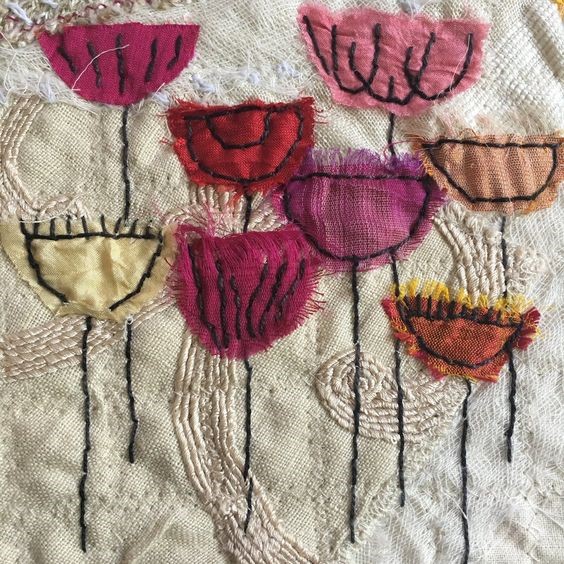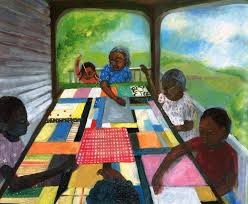Cleo Thoughts, Quilts
Five Reasons to Slow Stitch

Textileevolution.com
The tinkle of ice cubes in tall tea glasses blended with the chatter of women engaged in conversation. The scent of Italian dishes smothered in cheeses and oregano activated my salivary glands. It was going to be a satisfying meal with a group of readers that wanted me to talk about my books. So far, win-win.
The topic of quilts dominated the small table where I sat, because the focus of my presentation on the 1930’s hinged on the Sunbonnet Sue Quilt hanging in the front of the room. Every quilt has a story, and each attendee at this table shared the story of their treasured masterpiece of fabric. Then the conversation turned to hand quilting or machine quilting. The sophisticated, professional women eyed me with curiosity when I explained that my preference is hand quilting. Fans of the speed that machine stitching provides they leaned into the table to hear my reasons.

Photo from usefulbox.com.au
Slow Stitching Rationale
There are five reasons why creating a quilt with needle and thread is appealing to me. First, the process is quiet. No machine whining. No whirr of the bobbin. Just the sounds of the birds in the trees and the refrigerator in its cycle. In the solitude, thoughts in my head are able to speak to my heart without being quelled by noises of everyday life. This time of reflective silence is restorative.
Second, hand stitching is transportable. It can be carried to any room in the house, or even to other locations, like my son’s home. The project is not based in a lonesome room surrounded by stuff. A quilt can be stitched outside by the urban garden where the pollinators buzz. All that is needed is a small patchwork bag of supplies.
![]()
Maxpixel.net
Third, the act of slowly pressing a needle into cloth brings the mind into focus. Just doing this simple task settles the energy from multi-tasking to deliberation. Hand sewing provides a place to breathe. I find that order is restored as the quilt progresses. Being conscious of what I am doing and exactly how it is being done enhances creativity. Repetitive motions give the brain and emotions a place to go away from life’s chaos. The rhythm of the stitching brings the thoughts that fill my mind to mentally dance in and out of my concentration in a way that helps me to think clearly about difficulties. Moving the hands actually moves the thought process and weaves it towards a cohesive solution. Purposeful and focused immersion benefits the mind, heart and soul.
The fourth reason that slow stitching appeals to me is the link with a long legacy of women who drew satisfaction from the works of their fingers. Hand sewing connects me to the pioneer women who gathered around the campfires to repair the quilts stacked in the covered wagons. Needle and thread fought the Civil War as mothers and wives stitched patchwork for their soldier heading off to battle. My life becomes woven into the threads of the beleaguered farmers of the Great Depression who foraged for feed bag fabric to produce warm and cozy comforters in hard times. Hand work reminds me of my Aunt Lois and my mother, mending and creating fashion one slip of the needle at a time as they recalled their childhoods on the farm. Tea and toast flavored the companionship.
Finally, the fifth allure of slow stitching is the comfort of community that a circle of women can bring. Think of the Amish who gather to finish the top stitching of a quilt. Visualize a quilting bee in which children thread the needles for the 8-10 stitches an inch sew-ers. Join in on the conversations of the Gees Bend quilters as they comment on the day’s news, and then plan for the future. As the member of a group for many years, I found that the reason to go there was to be with the other women as much as to work on a project. It became a place where I belonged.

Gees Bend Quilters from myrtlebeachartmuseum.org
The Purpose of Life
Chatting with the women at the table over sandwiches and coffee, the differences between the goal-focused person and the process-focused person started to dawn on me. The individuals at this book review had pressed hard in their lives to achieve education, professional standing and community recognition. They were driven to achieve. When I finally framed the slow stitching movement as a journey, not a destination, they understood. But it didn’t mean that they could allow themselves to tamp down when their whole lives have been lived on overdrive. The lure of a fast press on the treadle and a bobbin wildly spinning excites them.
Truly, it takes an intentional act to “stop and smell the roses.” Or, in this case, to pick up a needle and thread, and sew on a piece of fabric.
Slow and easy.
“The meditative state that repetitive work can give you is really calming. “ – Emily Peacock, Slow Stitcher
